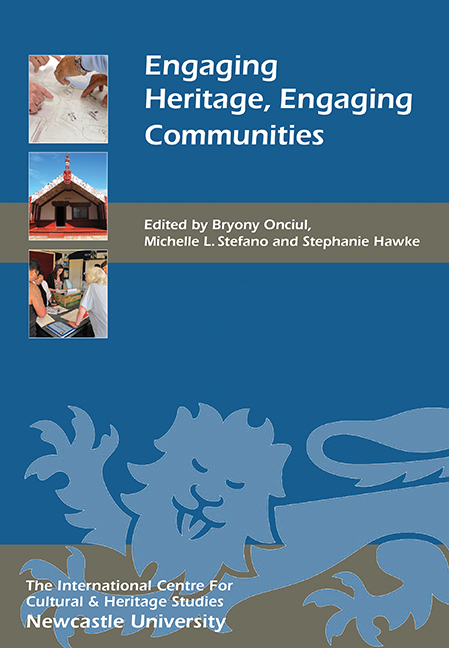Book contents
- Frontmatter
- Contents
- List of Illustrations
- Acknowledgments
- Introduction
- Engaging Concepts
- Engaging Creatively
- 7 Re-imagining Egypt: Artefacts, Contemporary Art and Community Engagement in the Museum
- 8 Interview – Evita Buša
- 9 Interview – Shatha Abu Khafajah
- 10 Engaging Communities of De–industrialisation: the Mapping Baybrook and Mill Stories Projects of Baltimore, USA
- 11 Interview – Ashley Minner
- Engaging Challenges
- List of Contributors
- Index
- Miscellaneous Endmatter
7 - Re-imagining Egypt: Artefacts, Contemporary Art and Community Engagement in the Museum
from Engaging Creatively
Published online by Cambridge University Press: 13 April 2017
- Frontmatter
- Contents
- List of Illustrations
- Acknowledgments
- Introduction
- Engaging Concepts
- Engaging Creatively
- 7 Re-imagining Egypt: Artefacts, Contemporary Art and Community Engagement in the Museum
- 8 Interview – Evita Buša
- 9 Interview – Shatha Abu Khafajah
- 10 Engaging Communities of De–industrialisation: the Mapping Baybrook and Mill Stories Projects of Baltimore, USA
- 11 Interview – Ashley Minner
- Engaging Challenges
- List of Contributors
- Index
- Miscellaneous Endmatter
Summary
What does Egypt conjure up in your imagination? Powerful pharaohs, towering pyramids, arid deserts, modern revolutions? Egypt has experienced many different cultural influences stretching back over 300,000 years. All eras of Egypt's past have helped shape the country today, yet the majority of the world is only familiar with one small part of the Egyptian story: the ‘Golden Age’ of the pharaohs. The exhibition Re-imagining Egypt, held at Saffron Walden Museum in the UK between 26 November 2013 and 23 February 2014, aimed to challenge this narrow view. Community engagement was central to this process, as almost 100 local school-age children were involved in a series of workshops at the museum that explored artefacts spanning the breadth of Egypt's past, from prehistory to present. Encouraging participants to make connections between different eras and themes, the workshops sparked creative ideas which moved beyond traditional representations of Egypt. The result was multiple artistic creations that were curated collaboratively alongside the historical objects and new artworks by the contemporary Egyptian artist Khaled Hafez, who was invited for a residency. The combination of art and artefact, ancient and modern, Egyptian and local (north-west Essex) perspectives in the exhibition set out to create a fresh vision of Egypt, both personal and historical. This chapter will discuss the theory, practice and outcomes of this process, analyse Re-imagining Egypt as a model for future community engagement in museums and ask whether the exhibition achieved its goal of representing Egypt as the sum of its many parts.
THE LEGACY OF ANCIENT EGYPT
The study and presentation of the ancient Egyptian past is affected by over 500 years of Western tradition. Excluding accounts from ancient Greece and Rome (Strassler 2007), sources as early as the sixteenth century reveal the collection and use of ancient Egyptian artefacts in the West. From the ingestion of mummia (ground mummy powder) for health (Dodson and Ikram 1998, 64) to pride of place in cabinets of curiosity (Impey and MacGregor 1985; MacGregor 1994; Bredekamp 1995) and later in the first museums, ancient Egyptian items offered a source of mysticism and grandeur on a previously unparalleled scale. This was important at a time when Western nations were building the foundations of modern science and struggling to establish their place in the world.
Ancient Egypt provided a source of both intellectual challenge and national competition.
- Type
- Chapter
- Information
- Engaging Heritage, Engaging Communities , pp. 91 - 106Publisher: Boydell & BrewerPrint publication year: 2017



